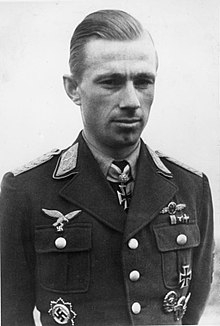
Back هيلموت لنت Arabic هيلموت لنت ARZ Helmut Lent Catalan Helmut Lent German Helmut Lent Spanish هلموت لنت Persian Helmut Lent Finnish Helmut Lent French הלמוט לנט HE Helmut Lent Italian
Helmut Lent | |
|---|---|
 Helmut Lent in 1943 | |
| Born | 13 June 1918 Pyrehne, Kingdom of Prussia, German Empire |
| Died | 7 October 1944 (aged 26) Paderborn, Free State of Prussia, Nazi Germany |
| Buried | Military cemetery at Stade |
| Allegiance | |
| Service/ | |
| Years of service | 1936–1944 |
| Rank | Oberst (posthumous) |
| Unit | ZG 76, NJG 1, NJG 2, NJG 3 |
| Commands held | IV./NJG 1, II./NJG 2, NJG 3 |
| Battles/wars | |
| Awards | Knight's Cross of the Iron Cross with Oak Leaves, Swords and Diamonds |
Helmut Lent (13 June 1918 – 7 October 1944) was a German night-fighter ace in World War II. Lent shot down 110 aircraft, 102 of them at night.[1][Note 1] Born into a devoutly religious family, he showed an early passion for glider flying; against his father's wishes, he joined the Luftwaffe in 1936. After completing his training, he was assigned to the 1. Squadron, or Staffel, of Zerstörergeschwader 76 (ZG 76), a wing flying the Messerschmitt Bf 110 twin-engine heavy fighter. Lent claimed his first aerial victories at the outset of World War II in the invasion of Poland and over the North Sea. During the invasion of Norway he flew ground support missions before he was transferred to the newly established Nachtjagdgeschwader 1 (NJG 1), a night-fighter wing.[2][3][Note 2]
Lent claimed his first nocturnal victory on 12 May 1941 and on 30 August 1941 was awarded the Knight's Cross of the Iron Cross for 22 victories. His steady accumulation of aerial victories resulted in regular promotions and awards. On the night of 15 June 1944, Major Lent was the first night fighter pilot to claim 100 nocturnal aerial victories, a feat which earned him the Knight's Cross of the Iron Cross with Oak Leaves, Swords and Diamonds on 31 July 1944.[2][3]
On 5 October 1944, Lent flew a Junkers Ju 88 on a routine transit flight from Stade to Nordborchen, 5 kilometres (3 mi) south of Paderborn. On the landing approach one of the engines cut out and the aircraft collided with power lines. All four members of the crew were fatally wounded. Three men died shortly after the crash and Lent succumbed to his injuries two days later on 7 October 1944.[2][3]
- ^ Spick 1996, pp. 3–4.
- ^ a b c Fraschka 1994, pp. 185–189.
- ^ a b c Williamson 2006, pp. 31–41.
Cite error: There are <ref group=Note> tags on this page, but the references will not show without a {{reflist|group=Note}} template (see the help page).
© MMXXIII Rich X Search. We shall prevail. All rights reserved. Rich X Search